The Level of E-Training Readiness at SQU: Dissertation Analysis
VerifiedAdded on 2023/04/22
|33
|5096
|275
Thesis and Dissertation
AI Summary
This dissertation presents the findings and analysis of a study on the level of e-training readiness at Sultan Qaboos University (SQU). The research aimed to assess the preparedness of administration employees for a proposed e-training paradigm shift, evaluating factors impacting readiness through questionnaires, surveys, and interviews. The study reveals that the majority of respondents were female, senior staff with significant computer and internet experience. The findings indicate a positive perception towards e-training, with participants believing it would be easy to learn and perform e-training tasks, and that it would enhance their interaction and technology skills. The data analysis, including descriptive statistics and t-tests, supports the conclusion that the respondents generally viewed e-training as useful for both personal and institutional progress, suggesting a high level of adoption readiness for the proposed paradigm shift. The study highlights the importance of e-training in higher education and provides valuable insights into the factors that influence its successful implementation.
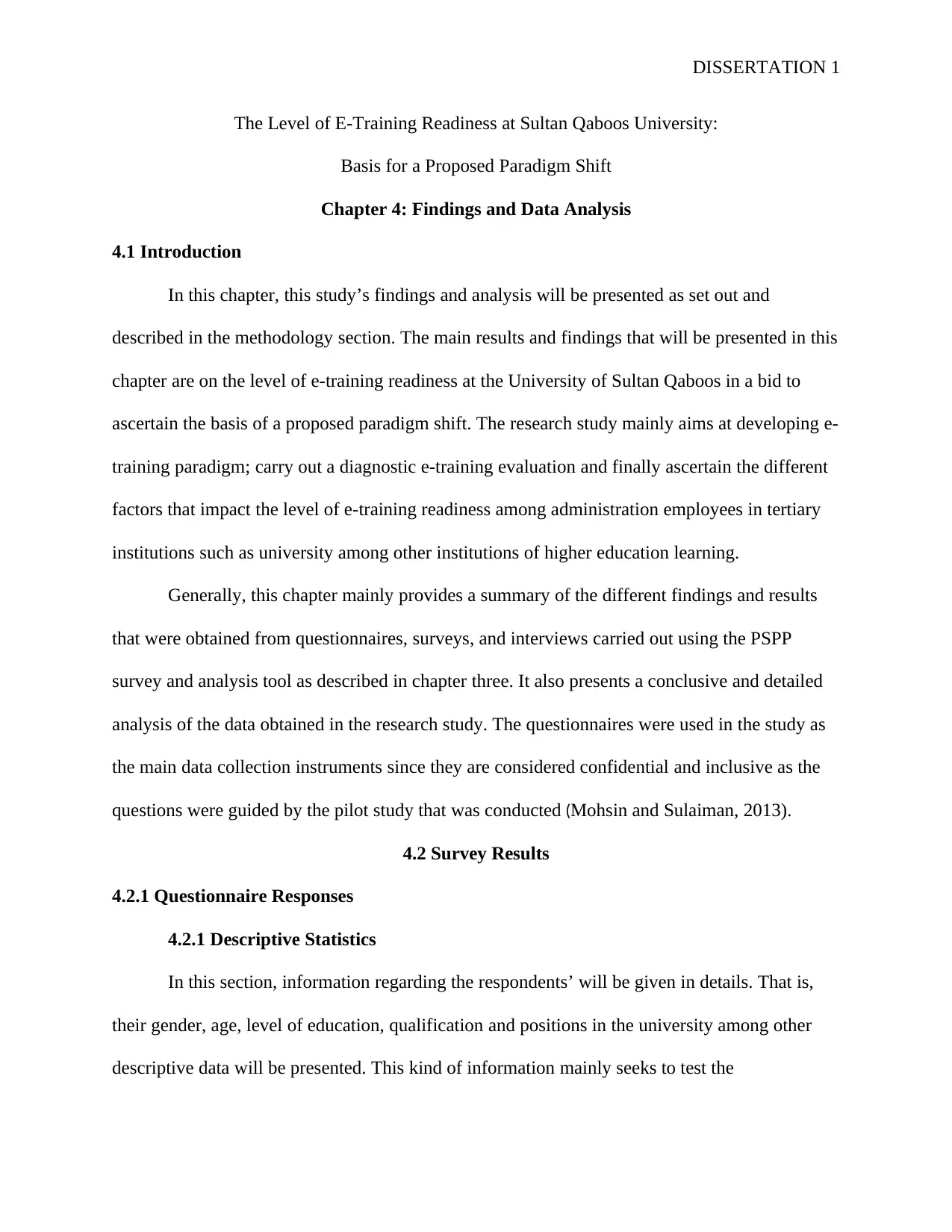
DISSERTATION 1
The Level of E-Training Readiness at Sultan Qaboos University:
Basis for a Proposed Paradigm Shift
Chapter 4: Findings and Data Analysis
4.1 Introduction
In this chapter, this study’s findings and analysis will be presented as set out and
described in the methodology section. The main results and findings that will be presented in this
chapter are on the level of e-training readiness at the University of Sultan Qaboos in a bid to
ascertain the basis of a proposed paradigm shift. The research study mainly aims at developing e-
training paradigm; carry out a diagnostic e-training evaluation and finally ascertain the different
factors that impact the level of e-training readiness among administration employees in tertiary
institutions such as university among other institutions of higher education learning.
Generally, this chapter mainly provides a summary of the different findings and results
that were obtained from questionnaires, surveys, and interviews carried out using the PSPP
survey and analysis tool as described in chapter three. It also presents a conclusive and detailed
analysis of the data obtained in the research study. The questionnaires were used in the study as
the main data collection instruments since they are considered confidential and inclusive as the
questions were guided by the pilot study that was conducted (Mohsin and Sulaiman, 2013).
4.2 Survey Results
4.2.1 Questionnaire Responses
4.2.1 Descriptive Statistics
In this section, information regarding the respondents’ will be given in details. That is,
their gender, age, level of education, qualification and positions in the university among other
descriptive data will be presented. This kind of information mainly seeks to test the
The Level of E-Training Readiness at Sultan Qaboos University:
Basis for a Proposed Paradigm Shift
Chapter 4: Findings and Data Analysis
4.1 Introduction
In this chapter, this study’s findings and analysis will be presented as set out and
described in the methodology section. The main results and findings that will be presented in this
chapter are on the level of e-training readiness at the University of Sultan Qaboos in a bid to
ascertain the basis of a proposed paradigm shift. The research study mainly aims at developing e-
training paradigm; carry out a diagnostic e-training evaluation and finally ascertain the different
factors that impact the level of e-training readiness among administration employees in tertiary
institutions such as university among other institutions of higher education learning.
Generally, this chapter mainly provides a summary of the different findings and results
that were obtained from questionnaires, surveys, and interviews carried out using the PSPP
survey and analysis tool as described in chapter three. It also presents a conclusive and detailed
analysis of the data obtained in the research study. The questionnaires were used in the study as
the main data collection instruments since they are considered confidential and inclusive as the
questions were guided by the pilot study that was conducted (Mohsin and Sulaiman, 2013).
4.2 Survey Results
4.2.1 Questionnaire Responses
4.2.1 Descriptive Statistics
In this section, information regarding the respondents’ will be given in details. That is,
their gender, age, level of education, qualification and positions in the university among other
descriptive data will be presented. This kind of information mainly seeks to test the
Paraphrase This Document
Need a fresh take? Get an instant paraphrase of this document with our AI Paraphraser
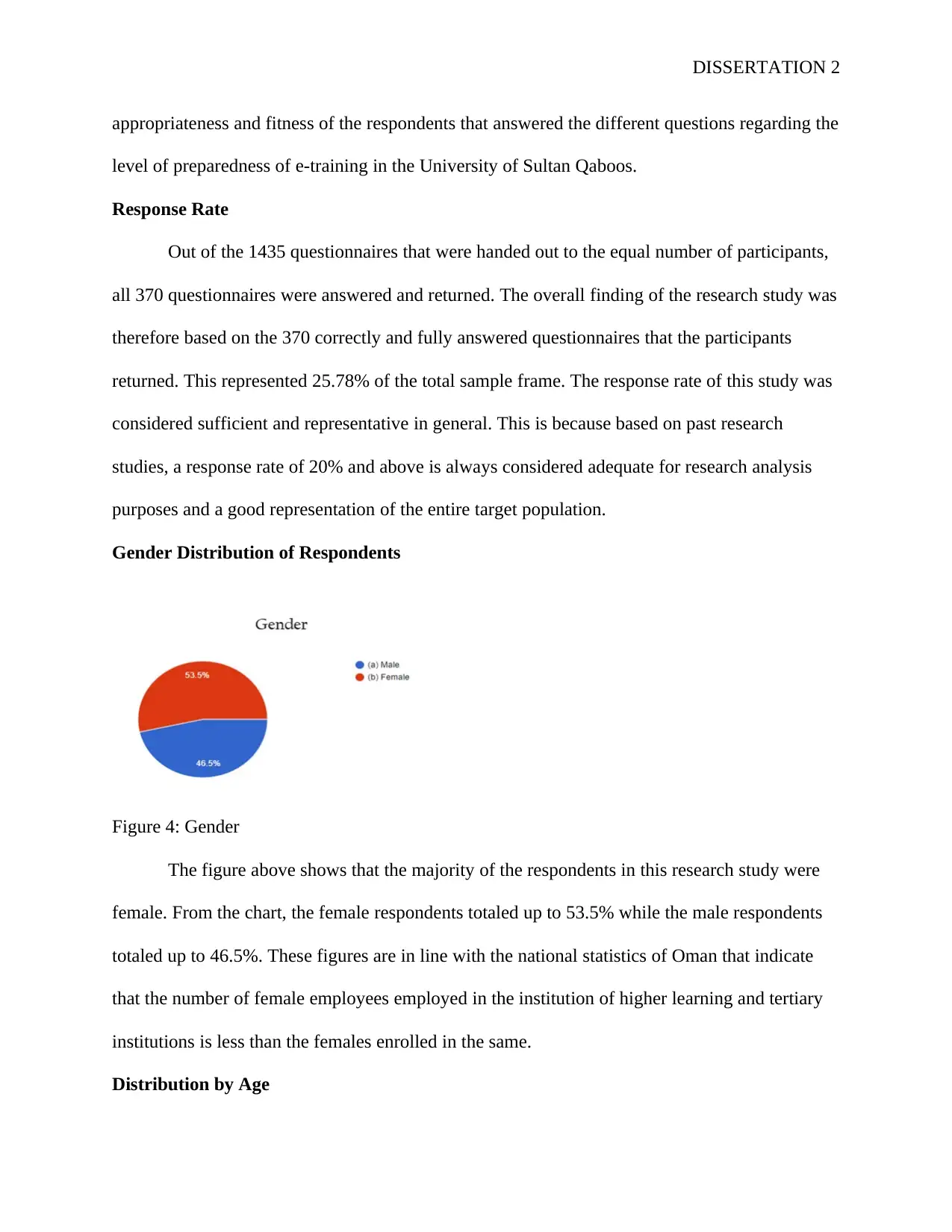
DISSERTATION 2
appropriateness and fitness of the respondents that answered the different questions regarding the
level of preparedness of e-training in the University of Sultan Qaboos.
Response Rate
Out of the 1435 questionnaires that were handed out to the equal number of participants,
all 370 questionnaires were answered and returned. The overall finding of the research study was
therefore based on the 370 correctly and fully answered questionnaires that the participants
returned. This represented 25.78% of the total sample frame. The response rate of this study was
considered sufficient and representative in general. This is because based on past research
studies, a response rate of 20% and above is always considered adequate for research analysis
purposes and a good representation of the entire target population.
Gender Distribution of Respondents
Figure 4: Gender
The figure above shows that the majority of the respondents in this research study were
female. From the chart, the female respondents totaled up to 53.5% while the male respondents
totaled up to 46.5%. These figures are in line with the national statistics of Oman that indicate
that the number of female employees employed in the institution of higher learning and tertiary
institutions is less than the females enrolled in the same.
Distribution by Age
appropriateness and fitness of the respondents that answered the different questions regarding the
level of preparedness of e-training in the University of Sultan Qaboos.
Response Rate
Out of the 1435 questionnaires that were handed out to the equal number of participants,
all 370 questionnaires were answered and returned. The overall finding of the research study was
therefore based on the 370 correctly and fully answered questionnaires that the participants
returned. This represented 25.78% of the total sample frame. The response rate of this study was
considered sufficient and representative in general. This is because based on past research
studies, a response rate of 20% and above is always considered adequate for research analysis
purposes and a good representation of the entire target population.
Gender Distribution of Respondents
Figure 4: Gender
The figure above shows that the majority of the respondents in this research study were
female. From the chart, the female respondents totaled up to 53.5% while the male respondents
totaled up to 46.5%. These figures are in line with the national statistics of Oman that indicate
that the number of female employees employed in the institution of higher learning and tertiary
institutions is less than the females enrolled in the same.
Distribution by Age
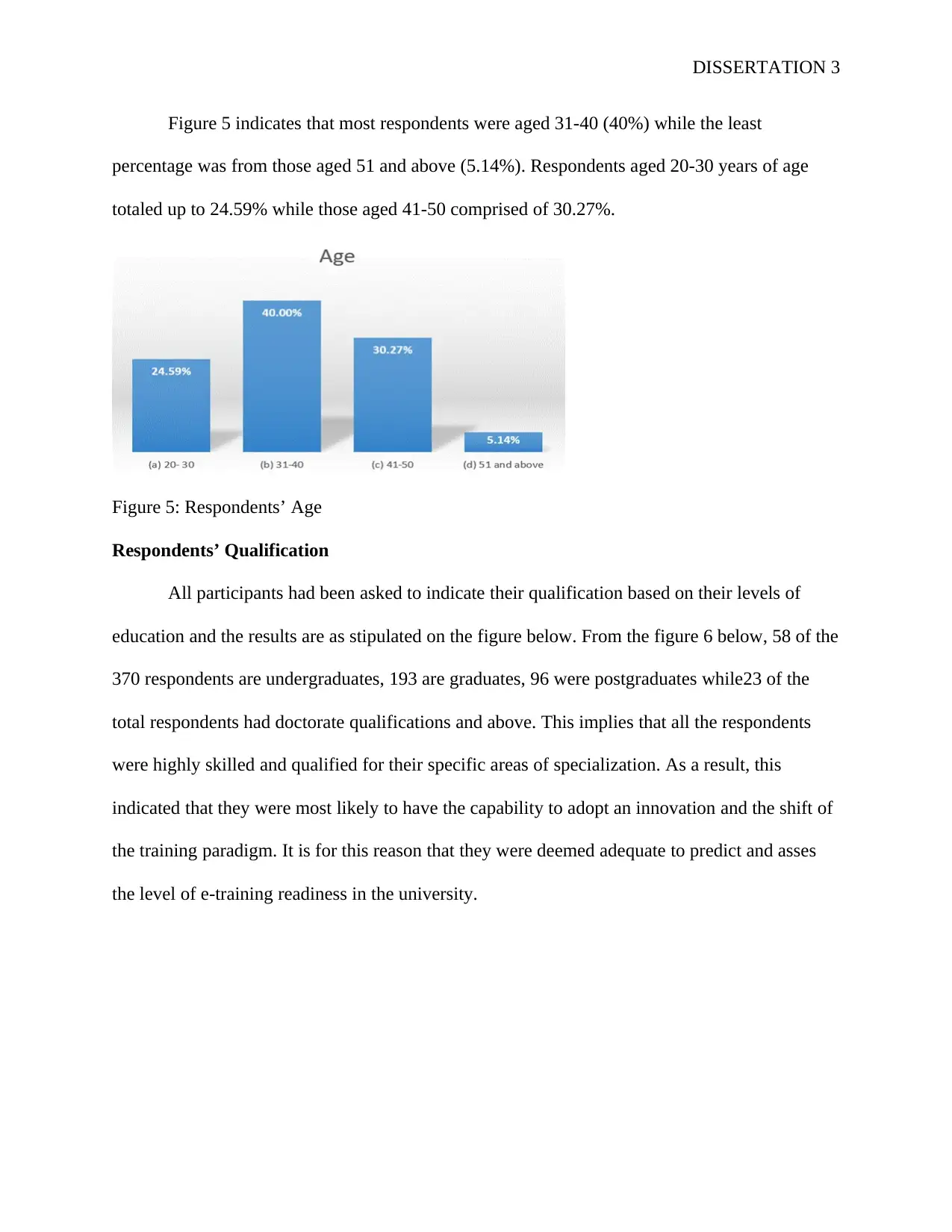
DISSERTATION 3
Figure 5 indicates that most respondents were aged 31-40 (40%) while the least
percentage was from those aged 51 and above (5.14%). Respondents aged 20-30 years of age
totaled up to 24.59% while those aged 41-50 comprised of 30.27%.
Figure 5: Respondents’ Age
Respondents’ Qualification
All participants had been asked to indicate their qualification based on their levels of
education and the results are as stipulated on the figure below. From the figure 6 below, 58 of the
370 respondents are undergraduates, 193 are graduates, 96 were postgraduates while23 of the
total respondents had doctorate qualifications and above. This implies that all the respondents
were highly skilled and qualified for their specific areas of specialization. As a result, this
indicated that they were most likely to have the capability to adopt an innovation and the shift of
the training paradigm. It is for this reason that they were deemed adequate to predict and asses
the level of e-training readiness in the university.
Figure 5 indicates that most respondents were aged 31-40 (40%) while the least
percentage was from those aged 51 and above (5.14%). Respondents aged 20-30 years of age
totaled up to 24.59% while those aged 41-50 comprised of 30.27%.
Figure 5: Respondents’ Age
Respondents’ Qualification
All participants had been asked to indicate their qualification based on their levels of
education and the results are as stipulated on the figure below. From the figure 6 below, 58 of the
370 respondents are undergraduates, 193 are graduates, 96 were postgraduates while23 of the
total respondents had doctorate qualifications and above. This implies that all the respondents
were highly skilled and qualified for their specific areas of specialization. As a result, this
indicated that they were most likely to have the capability to adopt an innovation and the shift of
the training paradigm. It is for this reason that they were deemed adequate to predict and asses
the level of e-training readiness in the university.
⊘ This is a preview!⊘
Do you want full access?
Subscribe today to unlock all pages.

Trusted by 1+ million students worldwide
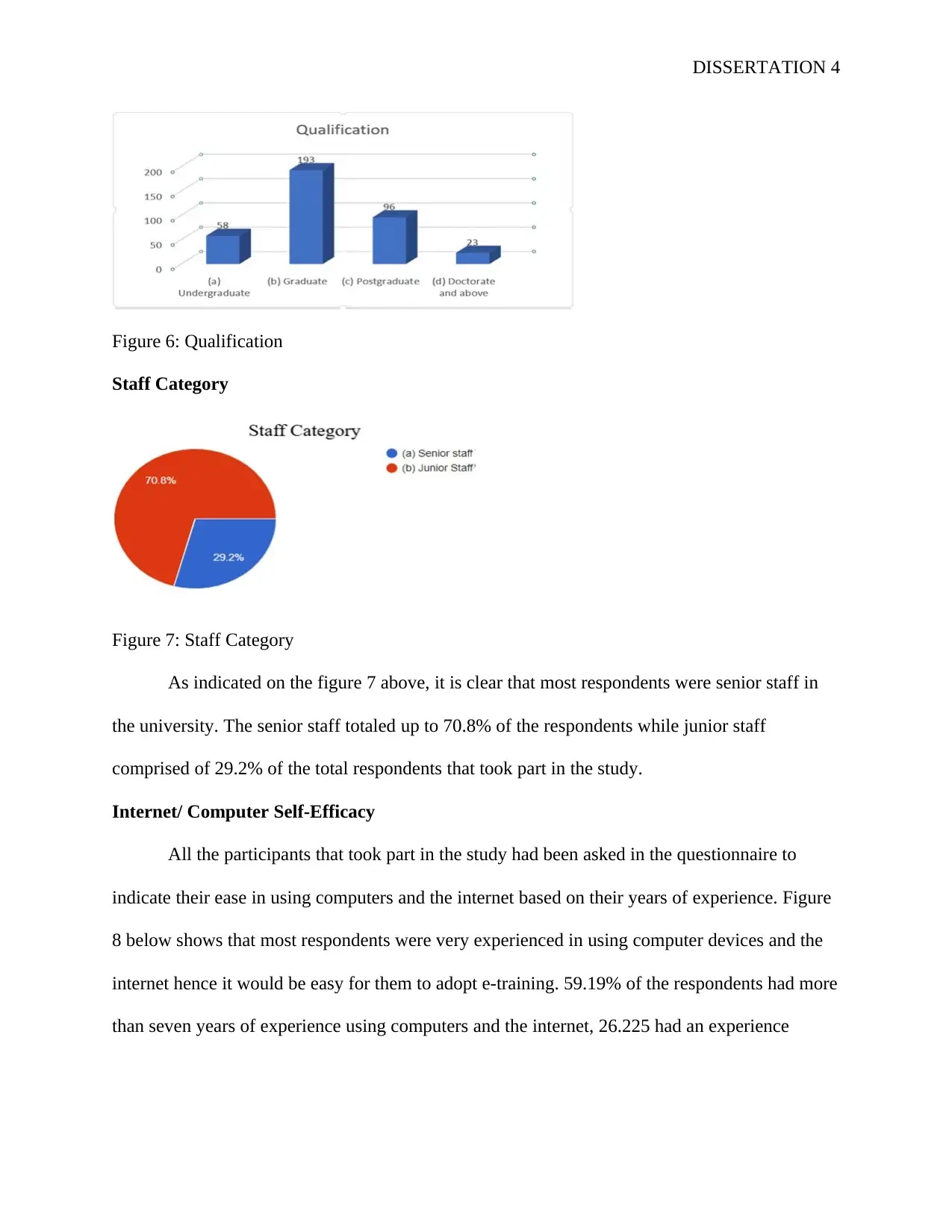
DISSERTATION 4
Figure 6: Qualification
Staff Category
Figure 7: Staff Category
As indicated on the figure 7 above, it is clear that most respondents were senior staff in
the university. The senior staff totaled up to 70.8% of the respondents while junior staff
comprised of 29.2% of the total respondents that took part in the study.
Internet/ Computer Self-Efficacy
All the participants that took part in the study had been asked in the questionnaire to
indicate their ease in using computers and the internet based on their years of experience. Figure
8 below shows that most respondents were very experienced in using computer devices and the
internet hence it would be easy for them to adopt e-training. 59.19% of the respondents had more
than seven years of experience using computers and the internet, 26.225 had an experience
Figure 6: Qualification
Staff Category
Figure 7: Staff Category
As indicated on the figure 7 above, it is clear that most respondents were senior staff in
the university. The senior staff totaled up to 70.8% of the respondents while junior staff
comprised of 29.2% of the total respondents that took part in the study.
Internet/ Computer Self-Efficacy
All the participants that took part in the study had been asked in the questionnaire to
indicate their ease in using computers and the internet based on their years of experience. Figure
8 below shows that most respondents were very experienced in using computer devices and the
internet hence it would be easy for them to adopt e-training. 59.19% of the respondents had more
than seven years of experience using computers and the internet, 26.225 had an experience
Paraphrase This Document
Need a fresh take? Get an instant paraphrase of this document with our AI Paraphraser
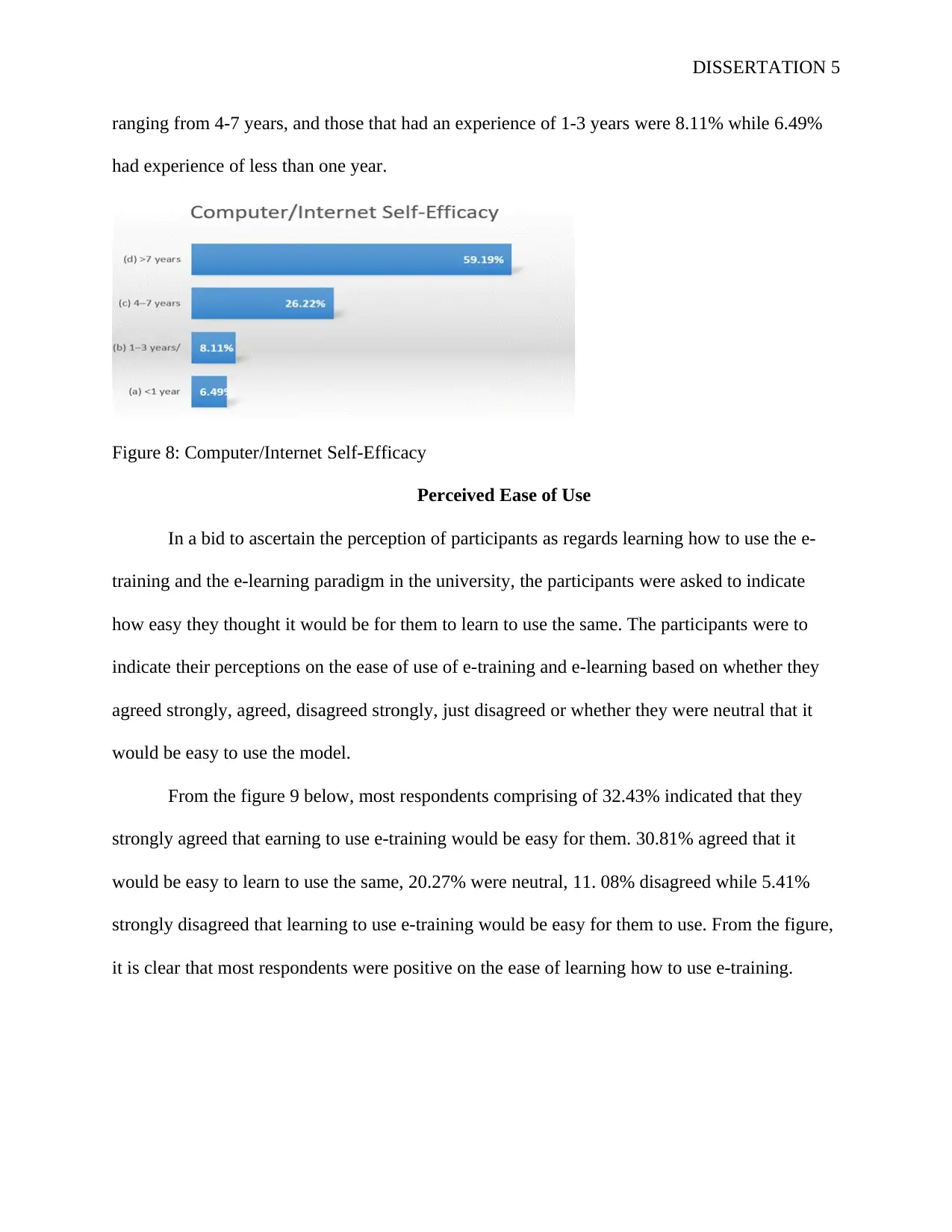
DISSERTATION 5
ranging from 4-7 years, and those that had an experience of 1-3 years were 8.11% while 6.49%
had experience of less than one year.
Figure 8: Computer/Internet Self-Efficacy
Perceived Ease of Use
In a bid to ascertain the perception of participants as regards learning how to use the e-
training and the e-learning paradigm in the university, the participants were asked to indicate
how easy they thought it would be for them to learn to use the same. The participants were to
indicate their perceptions on the ease of use of e-training and e-learning based on whether they
agreed strongly, agreed, disagreed strongly, just disagreed or whether they were neutral that it
would be easy to use the model.
From the figure 9 below, most respondents comprising of 32.43% indicated that they
strongly agreed that earning to use e-training would be easy for them. 30.81% agreed that it
would be easy to learn to use the same, 20.27% were neutral, 11. 08% disagreed while 5.41%
strongly disagreed that learning to use e-training would be easy for them to use. From the figure,
it is clear that most respondents were positive on the ease of learning how to use e-training.
ranging from 4-7 years, and those that had an experience of 1-3 years were 8.11% while 6.49%
had experience of less than one year.
Figure 8: Computer/Internet Self-Efficacy
Perceived Ease of Use
In a bid to ascertain the perception of participants as regards learning how to use the e-
training and the e-learning paradigm in the university, the participants were asked to indicate
how easy they thought it would be for them to learn to use the same. The participants were to
indicate their perceptions on the ease of use of e-training and e-learning based on whether they
agreed strongly, agreed, disagreed strongly, just disagreed or whether they were neutral that it
would be easy to use the model.
From the figure 9 below, most respondents comprising of 32.43% indicated that they
strongly agreed that earning to use e-training would be easy for them. 30.81% agreed that it
would be easy to learn to use the same, 20.27% were neutral, 11. 08% disagreed while 5.41%
strongly disagreed that learning to use e-training would be easy for them to use. From the figure,
it is clear that most respondents were positive on the ease of learning how to use e-training.
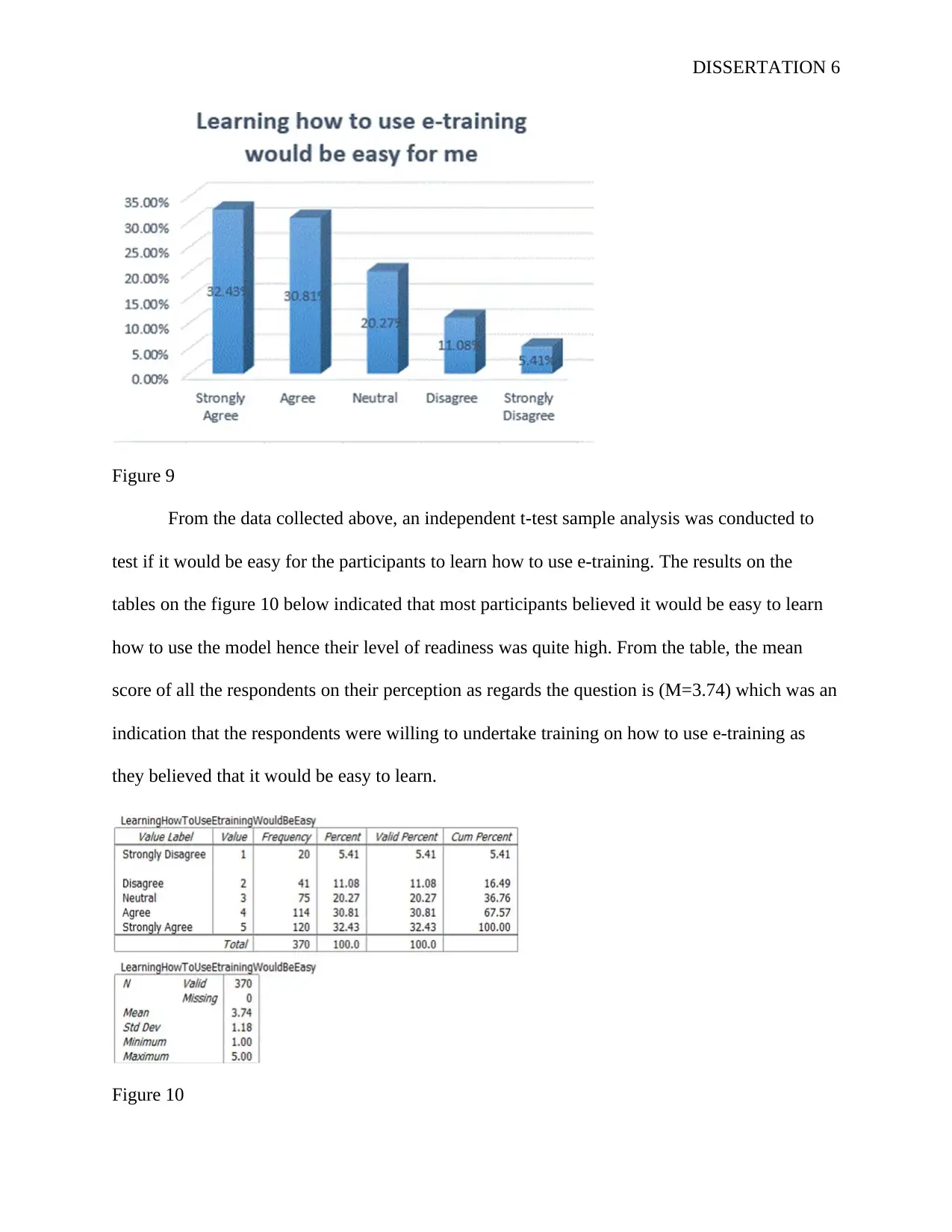
DISSERTATION 6
Figure 9
From the data collected above, an independent t-test sample analysis was conducted to
test if it would be easy for the participants to learn how to use e-training. The results on the
tables on the figure 10 below indicated that most participants believed it would be easy to learn
how to use the model hence their level of readiness was quite high. From the table, the mean
score of all the respondents on their perception as regards the question is (M=3.74) which was an
indication that the respondents were willing to undertake training on how to use e-training as
they believed that it would be easy to learn.
Figure 10
Figure 9
From the data collected above, an independent t-test sample analysis was conducted to
test if it would be easy for the participants to learn how to use e-training. The results on the
tables on the figure 10 below indicated that most participants believed it would be easy to learn
how to use the model hence their level of readiness was quite high. From the table, the mean
score of all the respondents on their perception as regards the question is (M=3.74) which was an
indication that the respondents were willing to undertake training on how to use e-training as
they believed that it would be easy to learn.
Figure 10
⊘ This is a preview!⊘
Do you want full access?
Subscribe today to unlock all pages.

Trusted by 1+ million students worldwide
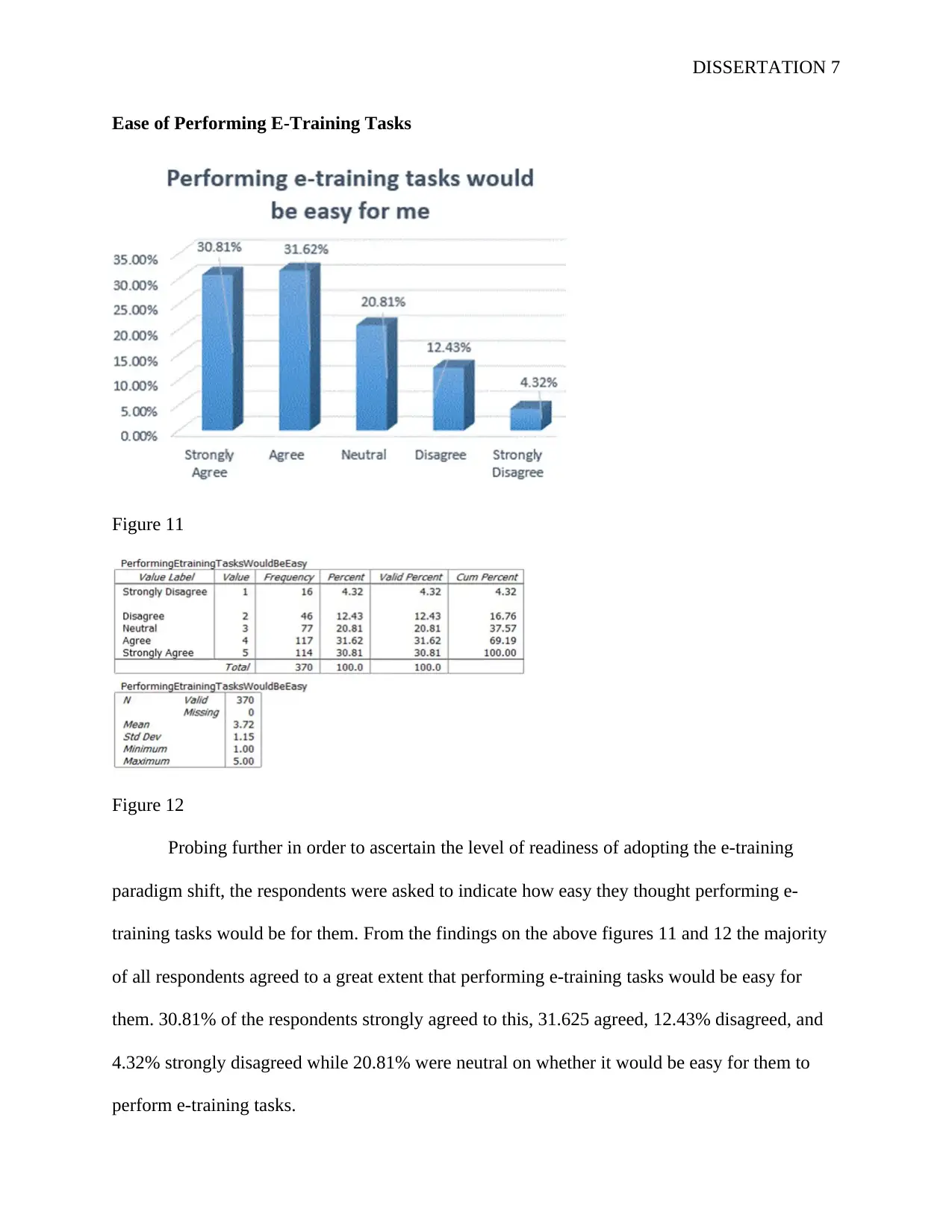
DISSERTATION 7
Ease of Performing E-Training Tasks
Figure 11
Figure 12
Probing further in order to ascertain the level of readiness of adopting the e-training
paradigm shift, the respondents were asked to indicate how easy they thought performing e-
training tasks would be for them. From the findings on the above figures 11 and 12 the majority
of all respondents agreed to a great extent that performing e-training tasks would be easy for
them. 30.81% of the respondents strongly agreed to this, 31.625 agreed, 12.43% disagreed, and
4.32% strongly disagreed while 20.81% were neutral on whether it would be easy for them to
perform e-training tasks.
Ease of Performing E-Training Tasks
Figure 11
Figure 12
Probing further in order to ascertain the level of readiness of adopting the e-training
paradigm shift, the respondents were asked to indicate how easy they thought performing e-
training tasks would be for them. From the findings on the above figures 11 and 12 the majority
of all respondents agreed to a great extent that performing e-training tasks would be easy for
them. 30.81% of the respondents strongly agreed to this, 31.625 agreed, 12.43% disagreed, and
4.32% strongly disagreed while 20.81% were neutral on whether it would be easy for them to
perform e-training tasks.
Paraphrase This Document
Need a fresh take? Get an instant paraphrase of this document with our AI Paraphraser
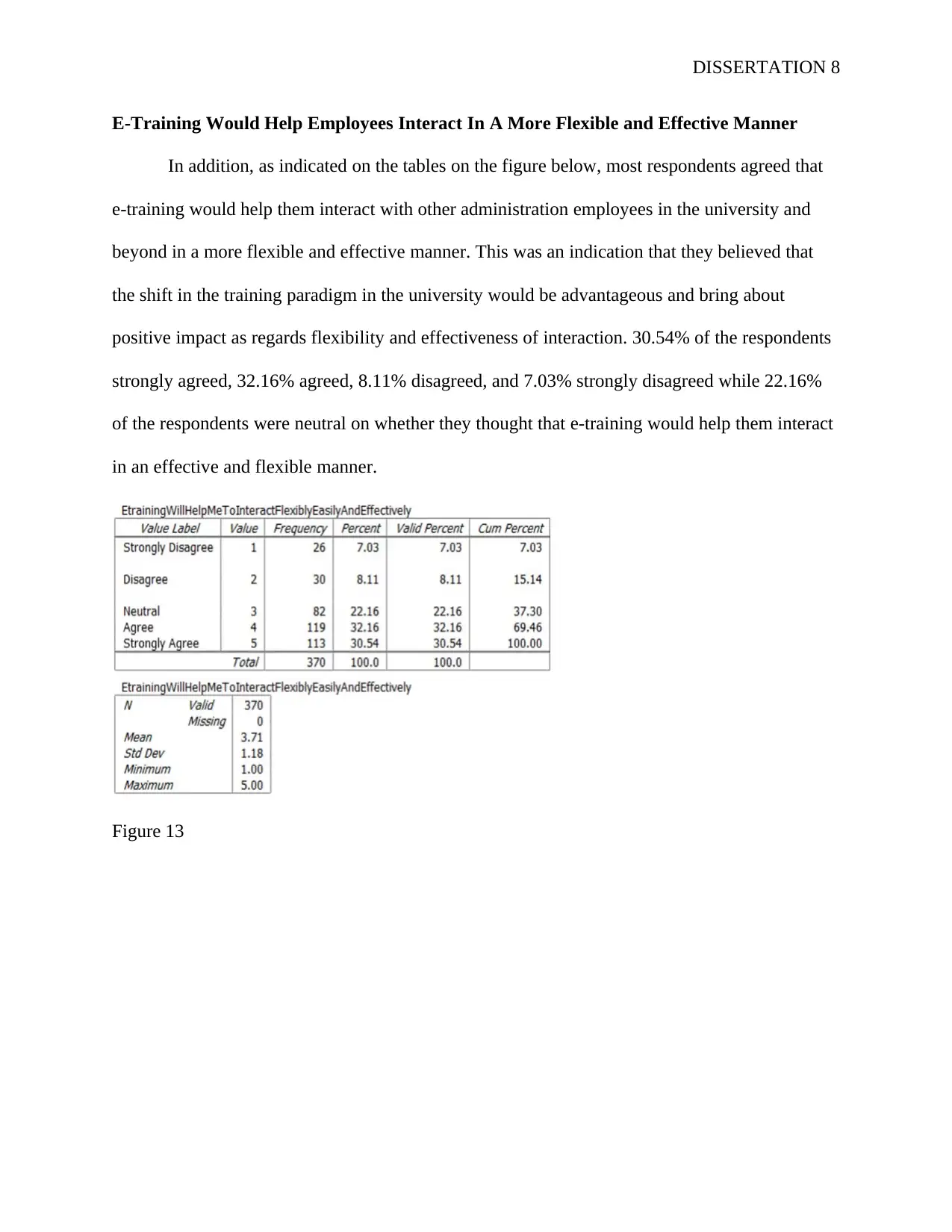
DISSERTATION 8
E-Training Would Help Employees Interact In A More Flexible and Effective Manner
In addition, as indicated on the tables on the figure below, most respondents agreed that
e-training would help them interact with other administration employees in the university and
beyond in a more flexible and effective manner. This was an indication that they believed that
the shift in the training paradigm in the university would be advantageous and bring about
positive impact as regards flexibility and effectiveness of interaction. 30.54% of the respondents
strongly agreed, 32.16% agreed, 8.11% disagreed, and 7.03% strongly disagreed while 22.16%
of the respondents were neutral on whether they thought that e-training would help them interact
in an effective and flexible manner.
Figure 13
E-Training Would Help Employees Interact In A More Flexible and Effective Manner
In addition, as indicated on the tables on the figure below, most respondents agreed that
e-training would help them interact with other administration employees in the university and
beyond in a more flexible and effective manner. This was an indication that they believed that
the shift in the training paradigm in the university would be advantageous and bring about
positive impact as regards flexibility and effectiveness of interaction. 30.54% of the respondents
strongly agreed, 32.16% agreed, 8.11% disagreed, and 7.03% strongly disagreed while 22.16%
of the respondents were neutral on whether they thought that e-training would help them interact
in an effective and flexible manner.
Figure 13
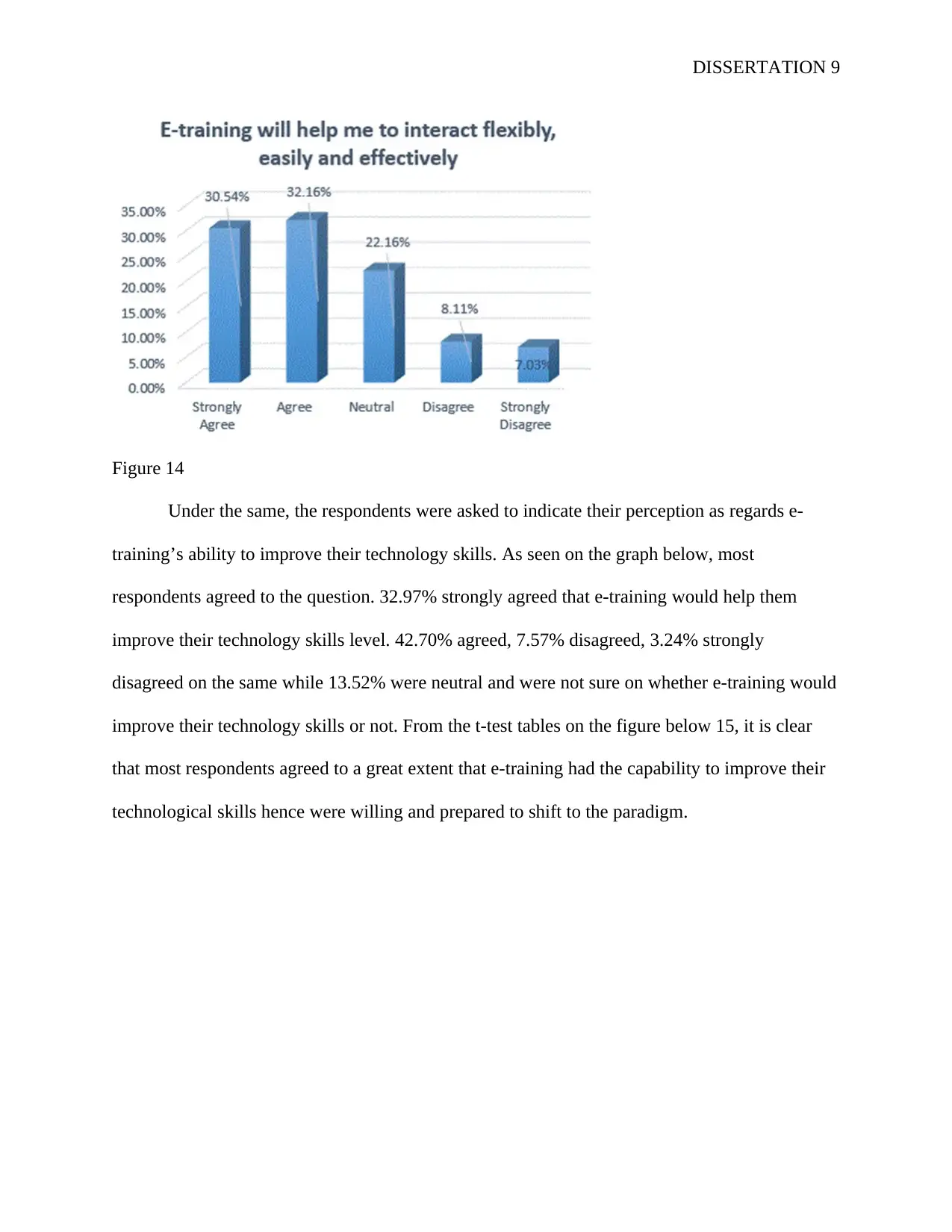
DISSERTATION 9
Figure 14
Under the same, the respondents were asked to indicate their perception as regards e-
training’s ability to improve their technology skills. As seen on the graph below, most
respondents agreed to the question. 32.97% strongly agreed that e-training would help them
improve their technology skills level. 42.70% agreed, 7.57% disagreed, 3.24% strongly
disagreed on the same while 13.52% were neutral and were not sure on whether e-training would
improve their technology skills or not. From the t-test tables on the figure below 15, it is clear
that most respondents agreed to a great extent that e-training had the capability to improve their
technological skills hence were willing and prepared to shift to the paradigm.
Figure 14
Under the same, the respondents were asked to indicate their perception as regards e-
training’s ability to improve their technology skills. As seen on the graph below, most
respondents agreed to the question. 32.97% strongly agreed that e-training would help them
improve their technology skills level. 42.70% agreed, 7.57% disagreed, 3.24% strongly
disagreed on the same while 13.52% were neutral and were not sure on whether e-training would
improve their technology skills or not. From the t-test tables on the figure below 15, it is clear
that most respondents agreed to a great extent that e-training had the capability to improve their
technological skills hence were willing and prepared to shift to the paradigm.
⊘ This is a preview!⊘
Do you want full access?
Subscribe today to unlock all pages.

Trusted by 1+ million students worldwide
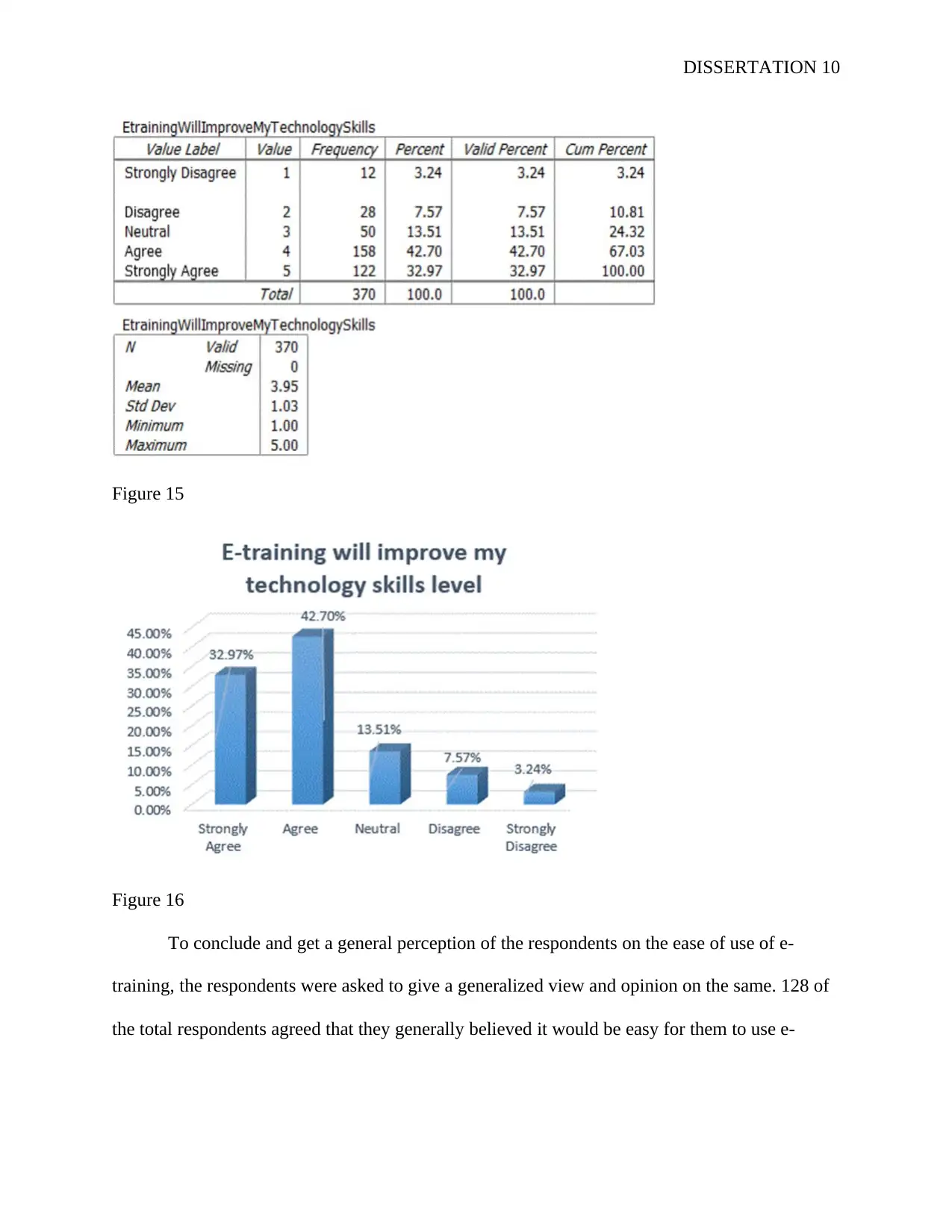
DISSERTATION 10
Figure 15
Figure 16
To conclude and get a general perception of the respondents on the ease of use of e-
training, the respondents were asked to give a generalized view and opinion on the same. 128 of
the total respondents agreed that they generally believed it would be easy for them to use e-
Figure 15
Figure 16
To conclude and get a general perception of the respondents on the ease of use of e-
training, the respondents were asked to give a generalized view and opinion on the same. 128 of
the total respondents agreed that they generally believed it would be easy for them to use e-
Paraphrase This Document
Need a fresh take? Get an instant paraphrase of this document with our AI Paraphraser
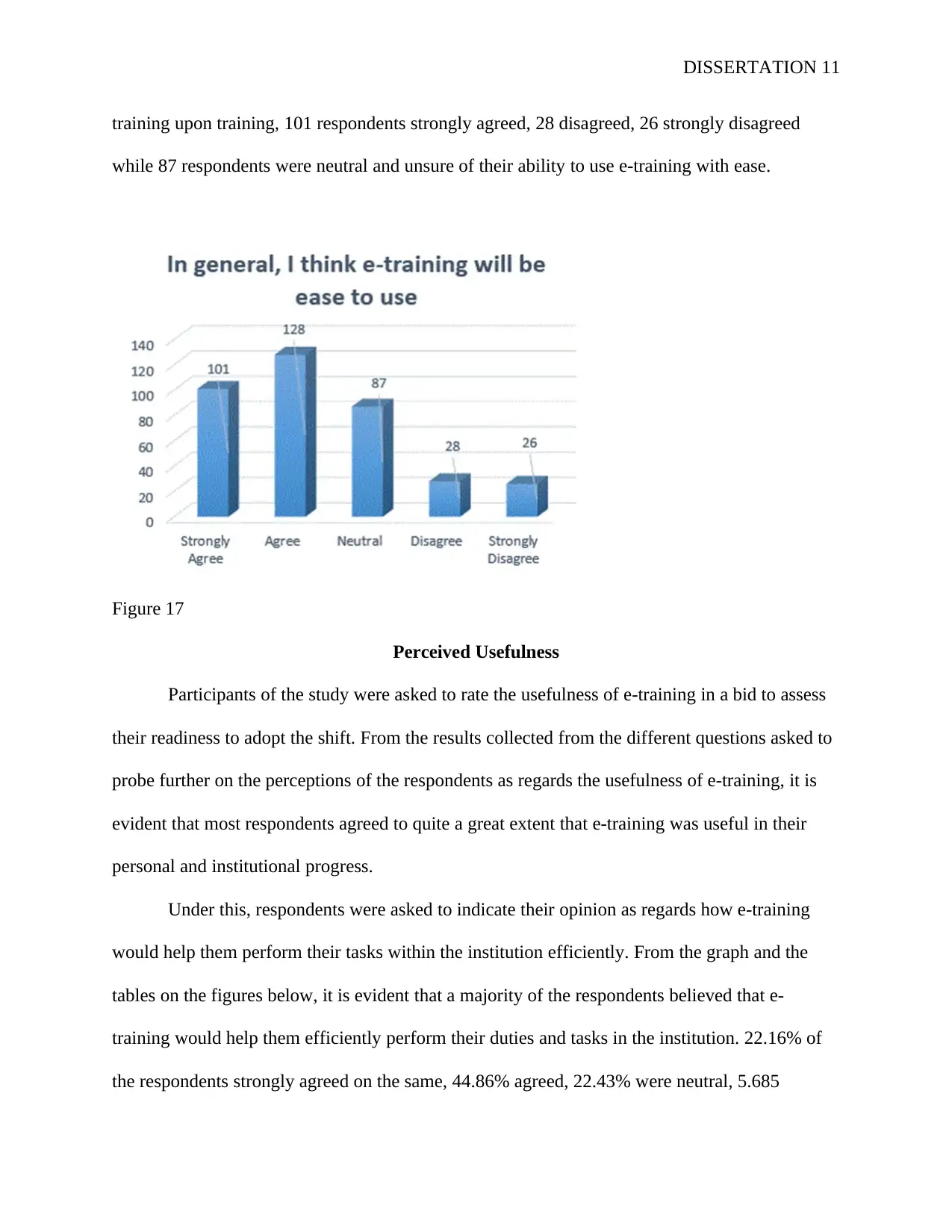
DISSERTATION 11
training upon training, 101 respondents strongly agreed, 28 disagreed, 26 strongly disagreed
while 87 respondents were neutral and unsure of their ability to use e-training with ease.
Figure 17
Perceived Usefulness
Participants of the study were asked to rate the usefulness of e-training in a bid to assess
their readiness to adopt the shift. From the results collected from the different questions asked to
probe further on the perceptions of the respondents as regards the usefulness of e-training, it is
evident that most respondents agreed to quite a great extent that e-training was useful in their
personal and institutional progress.
Under this, respondents were asked to indicate their opinion as regards how e-training
would help them perform their tasks within the institution efficiently. From the graph and the
tables on the figures below, it is evident that a majority of the respondents believed that e-
training would help them efficiently perform their duties and tasks in the institution. 22.16% of
the respondents strongly agreed on the same, 44.86% agreed, 22.43% were neutral, 5.685
training upon training, 101 respondents strongly agreed, 28 disagreed, 26 strongly disagreed
while 87 respondents were neutral and unsure of their ability to use e-training with ease.
Figure 17
Perceived Usefulness
Participants of the study were asked to rate the usefulness of e-training in a bid to assess
their readiness to adopt the shift. From the results collected from the different questions asked to
probe further on the perceptions of the respondents as regards the usefulness of e-training, it is
evident that most respondents agreed to quite a great extent that e-training was useful in their
personal and institutional progress.
Under this, respondents were asked to indicate their opinion as regards how e-training
would help them perform their tasks within the institution efficiently. From the graph and the
tables on the figures below, it is evident that a majority of the respondents believed that e-
training would help them efficiently perform their duties and tasks in the institution. 22.16% of
the respondents strongly agreed on the same, 44.86% agreed, 22.43% were neutral, 5.685
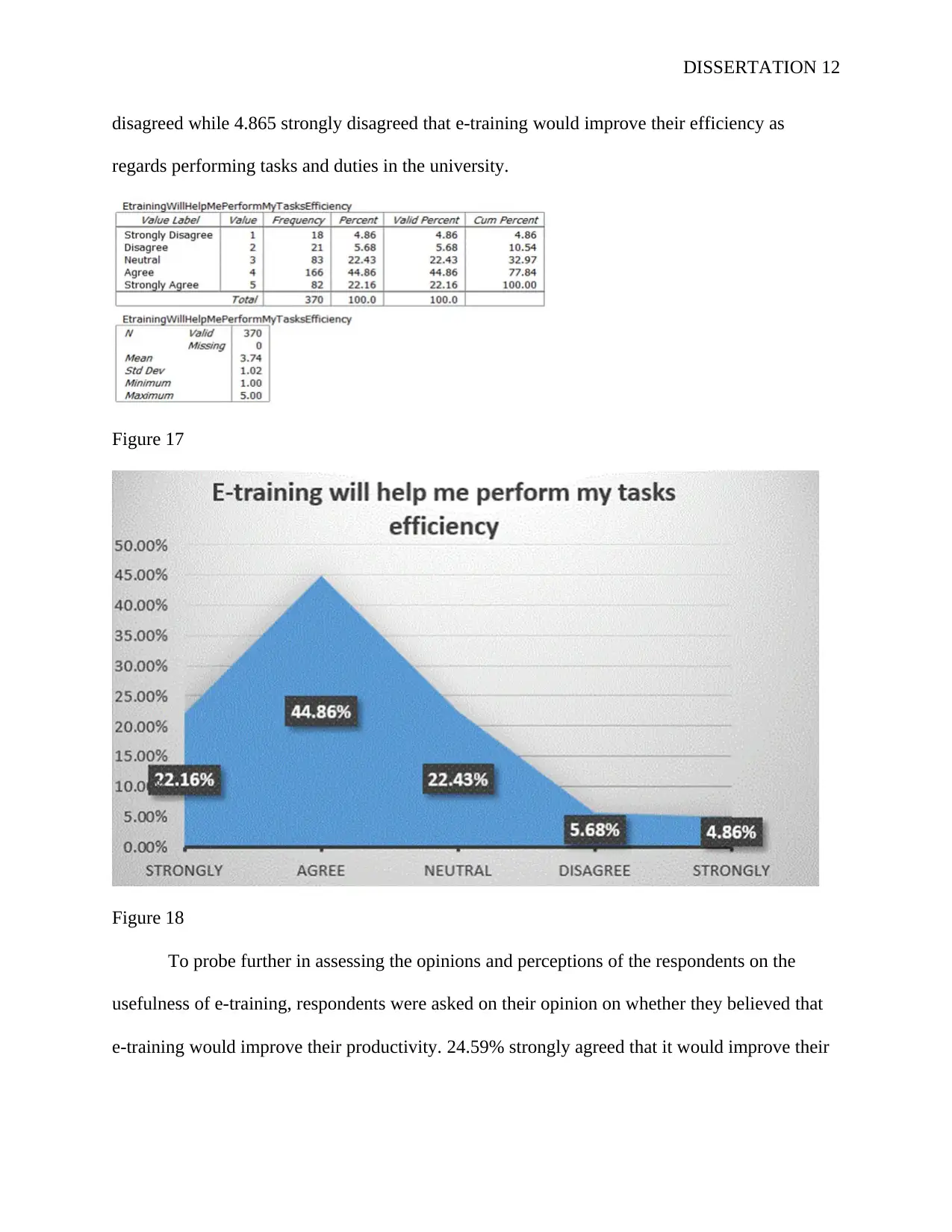
DISSERTATION 12
disagreed while 4.865 strongly disagreed that e-training would improve their efficiency as
regards performing tasks and duties in the university.
Figure 17
Figure 18
To probe further in assessing the opinions and perceptions of the respondents on the
usefulness of e-training, respondents were asked on their opinion on whether they believed that
e-training would improve their productivity. 24.59% strongly agreed that it would improve their
disagreed while 4.865 strongly disagreed that e-training would improve their efficiency as
regards performing tasks and duties in the university.
Figure 17
Figure 18
To probe further in assessing the opinions and perceptions of the respondents on the
usefulness of e-training, respondents were asked on their opinion on whether they believed that
e-training would improve their productivity. 24.59% strongly agreed that it would improve their
⊘ This is a preview!⊘
Do you want full access?
Subscribe today to unlock all pages.

Trusted by 1+ million students worldwide
1 out of 33
Related Documents
Your All-in-One AI-Powered Toolkit for Academic Success.
+13062052269
info@desklib.com
Available 24*7 on WhatsApp / Email
![[object Object]](/_next/static/media/star-bottom.7253800d.svg)
Unlock your academic potential
Copyright © 2020–2025 A2Z Services. All Rights Reserved. Developed and managed by ZUCOL.





